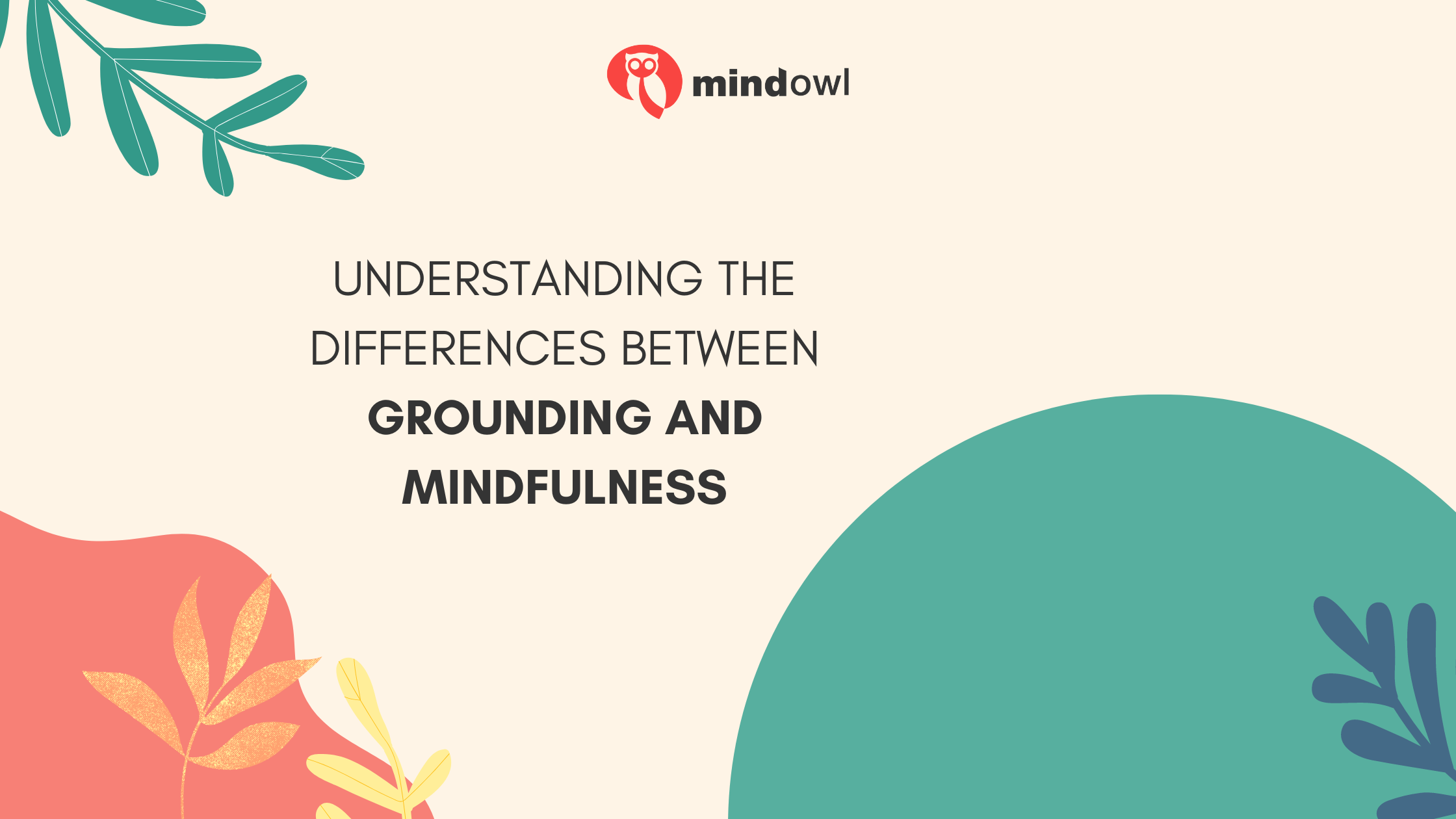Grounding and mindfulness are two banks of the river we can reach for stability. Despite their differences, both offer ways to manage our turbulent thoughts and bring us back to solid ground.
Mindfulness focuses on living in the now, paying close attention without judgment. Grounding techniques, however, anchor us during emotional storms by reconnecting with our bodily senses.
One fact people often mix up … mindfulness and grounding aren’t the same but each has its unique strength in calming mental whirlwinds. This article will guide you through understanding both practices so that next time life feels too much; you’ll know how to pull yourself back and stand firm.
Key Takeaways
- Mindfulness is about living in the present, using techniques like meditation and body scans. It trains our brain to focus on now, helping reduce stress.
- Grounding connects us with our bodily senses to manage anxiety. For an enhanced grounding experience, consider using the best grounding sheet to amplify the calming effect. Techniques include focusing on breath, holding a pebble, or naming things around you.
- Both mindfulness and grounding help us deal with feelings differently but aim to bring our attention back to the present moment for less stress.
Understanding Mindfulness

Mindfulness involves focusing on the present moment. Techniques for mindfulness include meditation and body scan exercises.
A Focus on the Present Moment
Paying attention to the present moment means noticing what you’re doing, feeling, and thinking right now. It’s about being aware without letting your mind wander to the past or worry about the future.
Mindfulness activities, like breathing deeply or focusing on a single object, help train your brain to stay in the present.
Mindfulness is not a magic spell—it’s training our minds to be where we are and fully engaging with whatever we’re doing at that moment.
Techniques such as body scans encourage you to notice each part of your body and any sensations it feels. This practice helps bring your attention back if it starts to drift away. Learning these skills makes it easier for us to manage stress because when we concentrate on the here and now, concerns about what’s coming next fade into the background.
Techniques for Mindfulness
Mindfulness skills help us live in the now. They let us experience life without getting caught up in past or future worries. Here are some key techniques:
- Find a comfy spot to sit or lie down. This is the first step towards calming your mind.
- Close your eyes and take deep breaths. Focus on how the air moves in and out of your body.
- Pay attention to your body. Notice any areas that feel tight or sore. Imagine your breath flowing to these parts, relaxing them.
- Listen to the sounds around you. Don’t judge them, just notice how they come and go.
- When thoughts pop into your head, it’s okay! Acknowledge them, then gently bring your focus back to your breath or body.
- Use mental images to guide you into relaxation. Picture yourself in a peaceful place, maybe a quiet beach or a serene forest.
- Practice being kind to yourself during mindfulness exercises and exercises alike—no judgment if you get distracted!
- Mindfulness meditation involves sitting quietly and paying attention to thoughts, sounds, the sensations of breathing or parts of the body, bringing your attention back whenever the mind starts wandering.
- Yoga can also be a form of mindfulness practice as it combines physical postures with breathing exercises and meditation.
These techniques don’t need much time—you can do them almost anywhere! The key is making these practices part of your daily routine for better mental health and relaxation.
Understanding Grounding
Grounding helps in centering oneself and managing anxiety. Its techniques involve connecting with the present moment to release tension and return to calmness.
Techniques to Centre Oneself
Grounding techniques help us stay present during stress. They bring us back when anxiety tries to take over. Here’s how you can centre yourself:
- Focus on your breath – Sit or stand comfortably and notice your breathing. Take slow, deep breaths in through your nose and out through your mouth. This helps calm the nervous system.
- Use a small stone – Keep a pebble or small stone in your pocket. Whenever you feel overwhelmed, hold it in your hand. Focus on its texture, shape, and temperature. It helps shift your attention away from distress.
- Name what you see around you – Look around and quietly name everything you can see, hear, smell, taste, and touch. Listing these things can pull you back to the present moment.
- Move your body – Stretch or walk slowly, paying attention to each movement of your toes up to your head. Movement can release tension and help you return to the now.
- Use compassionate self-talk – Speak kindly to yourself as if you were comforting a friend. Remind yourself that feelings are temporary and that you’re doing well by managing them.
- Visualise a safe place – Close your eyes and think of a place where you feel calm and safe. Imagine being there; what do you see, hear, smell? This visualisation brings peace when anxious thoughts hit hard.
- Write it down – Carry a notebook with you for moments of high stress or anxiety. Jot down what’s going on inside your mind without judgement. Writing helps organise thoughts and offers relief from intense emotions.
- Meditate briefly – Sit in a comfortable position for just five minutes daily; close your eyes and focus on one positive word or phrase that makes you feel at ease.
These methods are simple but powerful tools for staying grounded amidst chaos.
Grounding’s Role in Anxiety Management
Grounding exercises help people deal with intense anxiety, stress, panic attacks, and PTSD. These strategies make you focus on the present instead of bad memories or worries. Physical grounding techniques might include walking barefoot in grass to feel connected to the earth.
Mental grounding methods push your thoughts towards something positive or neutral right now.
Use grounding to refocus on the present and release tension.
These techniques not only distract from feelings of anxiety but also improve overall wellbeing. They bring both your body and mind back to what’s happening at this moment. This can be a big help during therapy sessions for trauma because it teaches how to cope by intentionally shifting attention away from stressful thoughts.

Comparing Mindfulness and Grounding
Mindfulness and grounding share similarities in helping us focus on the present and manage anxiety. Yet, they differ in techniques and purposes.
Similarities and Differences
Both mindfulness and grounding techniques bring our focus back to the present. They help us manage our feelings in different ways. Mindfulness makes us aware of our thoughts and surroundings without judgment.
Grounding, on the other hand, reconnects us with the earth to calm anxiety. They share a goal—to lessen stress—but they use unique paths to get there.
Mindfulness involves relaxation practices like meditation while grounding uses physical sensations, such as touching objects or noticing smells, to achieve calmness. Both can change how we act when emotions run high.
Yet, mindfulness asks us to observe from a distance, and grounding plugs us right into the here and now through our senses.
Conclusion
Mindfulness and grounding stand out as unique tools for managing our thoughts and feelings. Each has its own set of tactics—mindfulness brings us into the moment, while grounding anchors us in our body’s safety during stress or panic.
The 5-4-3-2-1 method is just one powerful example that shows how grounding can calm us down quickly. Knowing the differences helps you pick the right tool to center yourself or ease anxiety.
So, give these strategies a go; they might just change how you handle your day-to-day stresses!
FAQs
1. What’s the difference between mindfulness and grounding?
Mindfulness is about paying attention to the present moment, focusing on your thoughts, feelings, and surroundings with a non-judgmental attitude. Grounding, however, involves techniques that bring you back to the here and now when feeling overwhelmed or disconnected.
2. Can anyone practice these techniques?
Absolutely! Both grounding and mindfulness are skills that anyone can learn. Whether you’re a group looking for ways to help each other or someone seeking personal tools to release tension – there’s something for everyone.
3. How do grounding skills work?
Grounding skills work by distracting you from distressing feelings or thoughts and returning your focus to the present moment. This could be through physical exercises like touching an object or mental exercises such as naming things around you.
4. Are there exercises I can try at home?
Yes, there are plenty of exercises for both mindfulness and grounding that you can try at home – from simple meditation practices to mindfulness techniques focusing on breathing or sensory experiences.
5. Do I need a therapist to practice these techniques?
While having guidance from a therapist might enhance your practice, especially if you’re dealing with significant distress,, many people successfully implement these techniques on their own with great results.
6. Why should I bother learning about mindfulness and grounding?
Learning about these practices offers valuable tools for managing stress,, improving concentration,,and generally enhancing your well-being.. They encourage living in the moment which often leads to greater peace of mind.
MindOwl Founder – My own struggles in life have led me to this path of understanding the human condition. I graduated with a bachelor’s degree in philosophy before completing a master’s degree in psychology at Regent’s University London. I then completed a postgraduate diploma in philosophical counselling before being trained in ACT (Acceptance and commitment therapy).
I’ve spent the last eight years studying the encounter of meditative practices with modern psychology.

